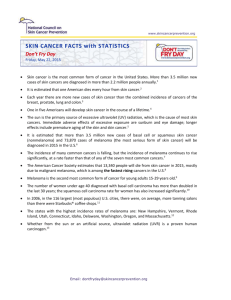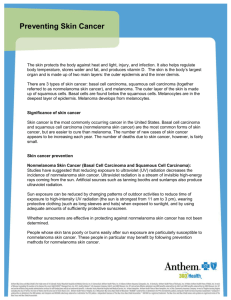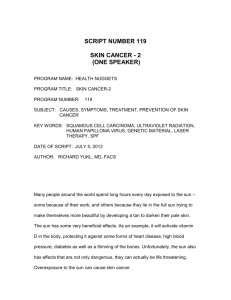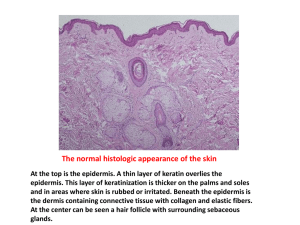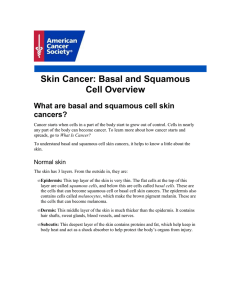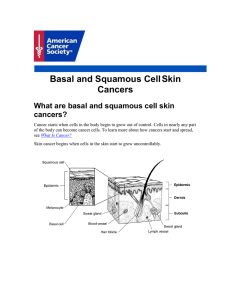File
advertisement
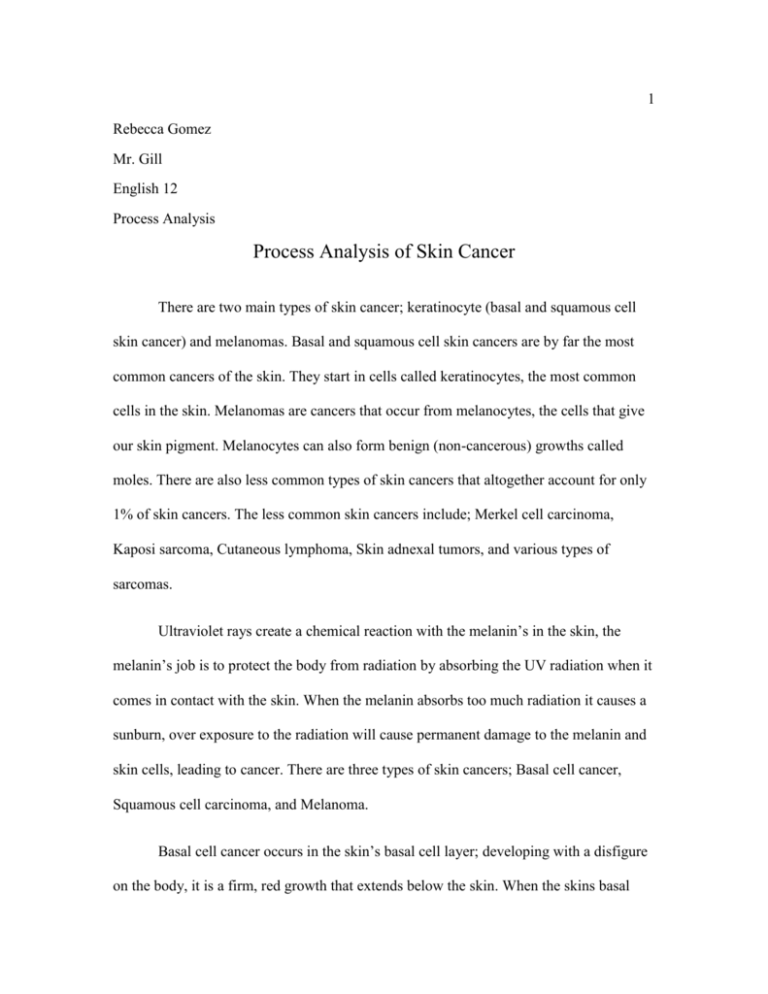
1 Rebecca Gomez Mr. Gill English 12 Process Analysis Process Analysis of Skin Cancer There are two main types of skin cancer; keratinocyte (basal and squamous cell skin cancer) and melanomas. Basal and squamous cell skin cancers are by far the most common cancers of the skin. They start in cells called keratinocytes, the most common cells in the skin. Melanomas are cancers that occur from melanocytes, the cells that give our skin pigment. Melanocytes can also form benign (non-cancerous) growths called moles. There are also less common types of skin cancers that altogether account for only 1% of skin cancers. The less common skin cancers include; Merkel cell carcinoma, Kaposi sarcoma, Cutaneous lymphoma, Skin adnexal tumors, and various types of sarcomas. Ultraviolet rays create a chemical reaction with the melanin’s in the skin, the melanin’s job is to protect the body from radiation by absorbing the UV radiation when it comes in contact with the skin. When the melanin absorbs too much radiation it causes a sunburn, over exposure to the radiation will cause permanent damage to the melanin and skin cells, leading to cancer. There are three types of skin cancers; Basal cell cancer, Squamous cell carcinoma, and Melanoma. Basal cell cancer occurs in the skin’s basal cell layer; developing with a disfigure on the body, it is a firm, red growth that extends below the skin. When the skins basal 2 cell layer is exposed to excessive sunlight, a form of DNA damage called thymine dimers occurs. The skin cells then try to repair the damage but when they fail to remove all of the damage, causing the mutations to replicate over time with the skin cells. This causes the development of cancerous tumors. It is rare to die from basal cell cancer, the most damage done are the disfigures to the body. Squamous cell carcinoma develops just below the outer skin, known as the epidermis. Basal cells are the bottom of the epidermis, and these cells are responsible for creating new skin cells. In healthy skin old skin cells die and are pushed towards the epidermis by new skin cells, and at the surface of the skin the old skin cells are shed. When the UV radiation damages the DNA of squamous cells, the old cells are not shed as they should be, therefor causing a cancerous lesion. It resembles scaly, red patches on the skin; the patches can become crusted and causing pain, the scaly spots only show up on areas exposed to the skin. Melanoma develops when the cells that produce melanin, known as melanocytes are damaged. Melanin gives skin its pigmentation and are always reproducing and shedding, just like squamous basal cells. Over exposure to UV radiation can lead to DNA activating oncogenes, genes that make the cell cancerous. Also damaging the cell itself, causing the cells renewal and shedding process to be disrupted, causing the cells to grow in an abnormal way, leading to a tumor or lesion. Melanoma leads to the most cancer related deaths, usually showing up as a mole or dark patch on the skin that then begins growing and changing. Melanoma can also spread into other parts of the body, which 3 makes it a deadly form of skin cancer. If a patient has been diagnosed with nonmelanoma skin cancer tests are done to see if the cancer cells within the skin or to other parts of the body; this process is called staging. The information found by the staging process determines the stage of the disease. It is important to know the stage so that treatment may begin. An MRI, CAT scan, or a Lymph node biopsy are used to determine the stage of cancer. There are three ways that cancer spreads throughout the body, and they are; through tissue, the cancer invades the surrounding normal tissue. Through the lymph system; cancer invades the lymph system and travels through the lymph vessels to other places in the body. And lastly, through the blood; cancer invades the veins and capillaries, then traveling through the blood to other places in the body. When cancer breaks away from the original tumor and travels through the lymph or blood to other places in the body another tumor may form. The process is called metastasis. The second metastatic tumor is the same type of cancer as the first. Cancer may take awhile to appear but once it does it moves quickly, this is why everyone should know their body and keep a look out for unusual signs of any cancers. Works Cited Harms, Nicole. "How Does Skin Cancer Occur? | EHow." EHow. Demand Media, 28 Oct. 2008. Web. 15 Jan. 2014. "How Does Skin Cancer Affect the Body?" - Skin Cancers. N.p., n.d. Web. 15 Jan. 2014. "National Cancer Institute." Skin Cancer Treatment (PDQ®) -. N.p., n.d. Web. 15 Jan. 2014.

